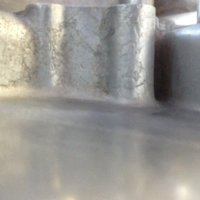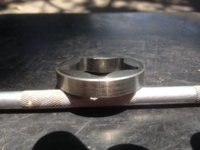Hmm. Technique is a biggie doing this. Kinda late but IMHO I'd make sure any raised edges at the gouge were removed and call it good. I feel like a rain cloud but suspect things are worse now than when you started. Looks like you have achieved some pretty good rounding off here and there, tho pics are deceiving. These pumps are pretty robust and damage tolerant.
I think were I to attempt a resurface of the face on the cover I'd have paper on a flat mandrel mounted in a low speed drill or better, a drill press with the cover supported on the table to maintain parallel to the mandrel. I'd work with water on 600 wet or dry and a very slow spindle speed. I'd be happiest if I could slide the cover around a bit to change where the mandrel centers on the pump surface.
Another method would be to a use 2" +- hole saw and cut a disk out of plywood sand plywood flat on a flat surface then bevel the top of the center hole large enough that a largish dowel with a rounded end could be used to slide the "puck" back and forth on the surface without adding user induced "crooked loading" use disks cut out of fine wet or dry paper and work wet. But as mentioned the pumps can look pretty awful and still do the job needed just fine.
I think were I to attempt a resurface of the face on the cover I'd have paper on a flat mandrel mounted in a low speed drill or better, a drill press with the cover supported on the table to maintain parallel to the mandrel. I'd work with water on 600 wet or dry and a very slow spindle speed. I'd be happiest if I could slide the cover around a bit to change where the mandrel centers on the pump surface.
Another method would be to a use 2" +- hole saw and cut a disk out of plywood sand plywood flat on a flat surface then bevel the top of the center hole large enough that a largish dowel with a rounded end could be used to slide the "puck" back and forth on the surface without adding user induced "crooked loading" use disks cut out of fine wet or dry paper and work wet. But as mentioned the pumps can look pretty awful and still do the job needed just fine.










